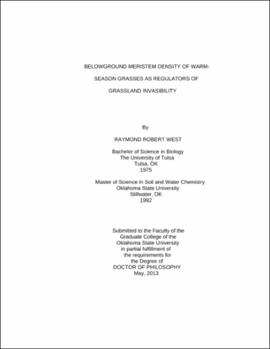| dc.description.abstract | Recent studies suggest that perennial grasslands susceptibility to invasions (i.e. invasibility) by exotic plants may be related to the population of native grass belowground meristems (the "bud bank") in these plant communities. In perennial grasslands, the belowground bud bank plays a fundamental role in local plant population persistence, structure and dynamics; all important factors determining invasibility. Using greenhouse and multiple field sites, Konza Prairie Biological Station (KPBS) and Oklahoma State University - Range Research Station (OSU-RRS), the following hypotheses were tested: 1) Bud:tiller ratios decrease with decreasing bud banks; 2) Increases in bud bank size will lead to increases in grassland stability, thereby reducing invasibility; and 3) Grassland invasibility is regulated by a minimum threshold in bud bank densities. Treatment levels were created by establishing a 0%, 33%, 66%, and 100% bud bank gradient of natural field densities of Schizachyrium scoparium (greenhouse), and Schizachyrium scoparium, Andropogon gerardii, Sorghastrum nutans, and Panicum virgatum (field). Invasive species Bothriochloa bladhii at KPBS and Bothriochloa ischaemum, Bromus japonicus, and Lespedeza cuneata at OSU-RRS and greenhouse were sown in each plot and mesocosm at a rate of 300 seeds species-1 m-2. At greenhouse and both field sites, the lowest meristem density (0%) substantially decreased stability and increased invasibility of my grassland community. No significant differences were observed in bud:tiller ratios between the various bud bank density plots at KPBS and OSU-RRS. KPBS and OSU-RRS 2-year average KPBS and OSU-RRS 2-year average, and greenhouse (1-year) aboveground exotic species biomass from plots and mesocosms absent of bud bank (0%) was 10,165%, 467% and 800% greater than the low (33%) bud bank density plots, respectively. However, no relationship was observed between the various bud bank densities (33%, 66%, or 100%) and invasibility of these grassland communities (field) and populations (greenhouse). At both sites and greenhouse, the exotic species biomass production was not proportional to the bud bank population, and suggests the existence of an invasibility threshold between 0 and 33% of the bud bank density. An important implication of these findings is that perennial grasslands that maintain large bud banks are most resistant to exotic species invasions. | |
